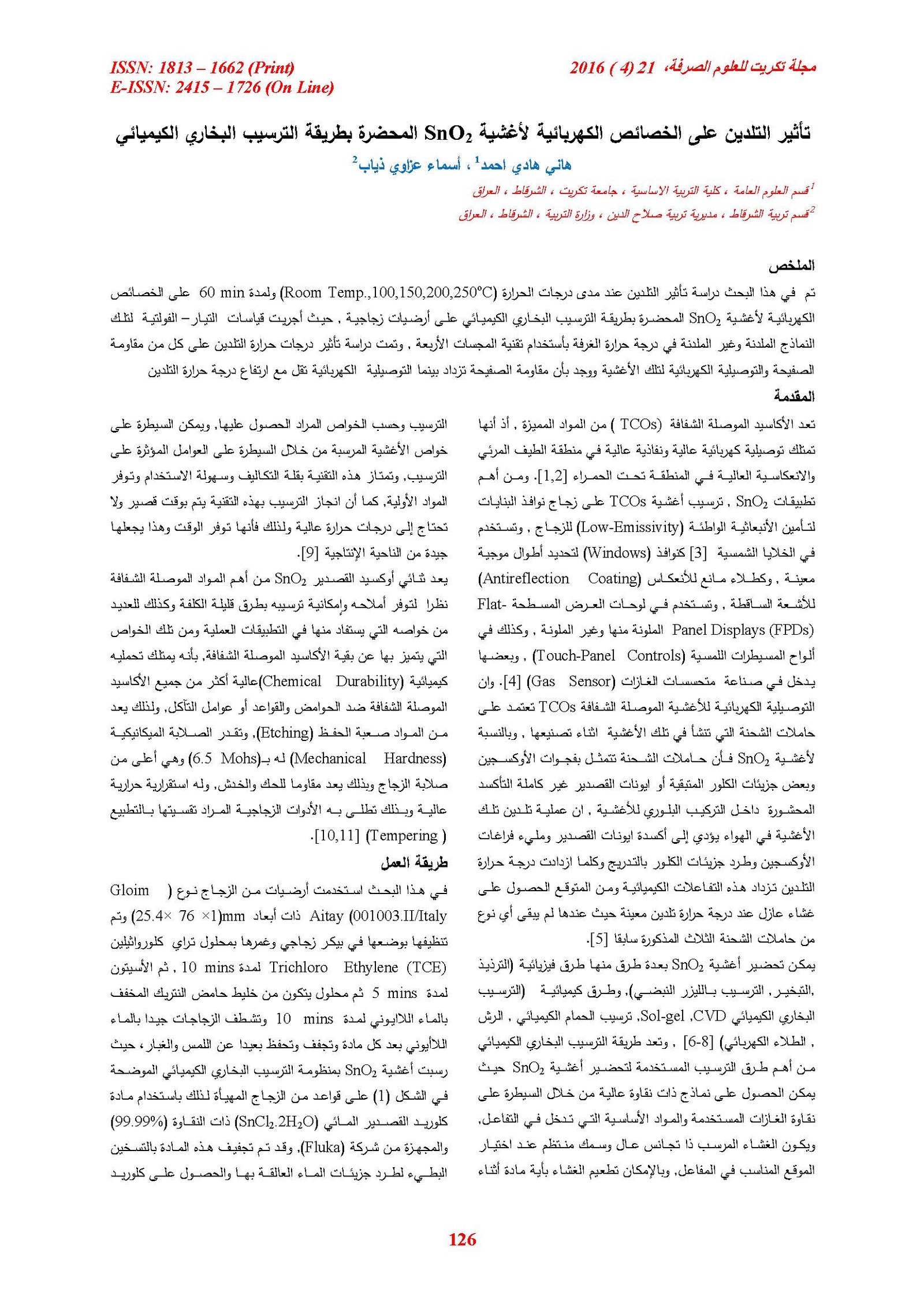The Effect of Annealing on the Electrical Characteristics of SnO2 Films by a Chemical Steamy Deposition Method
Main Article Content
Abstract
In this research, the effect of the annealing at (Room Temp.,100,150,200,250oC) for 60 min on the electrical characteristics of SnO2 films has been Studied in a chemical steamy deposition method on glassiness grounds. Then measurements of the Volt-Current have been made for colourful and uncolourful models in room temperature by using the fourth tentacles technique. A study of the annealing temperature effect has been made on the opposition of the Sheet and the electrical conduction of these films. It has been found that the opposing of the sheet goes up whereas the electrical conduction reduces with the height of annealing temperature with the scope of the studied temperatures.
Article Details

This work is licensed under a Creative Commons Attribution 4.0 International License.
Tikrit Journal of Pure Science is licensed under the Creative Commons Attribution 4.0 International License, which allows users to copy, create extracts, abstracts, and new works from the article, alter and revise the article, and make commercial use of the article (including reuse and/or resale of the article by commercial entities), provided the user gives appropriate credit (with a link to the formal publication through the relevant DOI), provides a link to the license, indicates if changes were made, and the licensor is not represented as endorsing the use made of the work. The authors hold the copyright for their published work on the Tikrit J. Pure Sci. website, while Tikrit J. Pure Sci. is responsible for appreciate citation of their work, which is released under CC-BY-4.0, enabling the unrestricted use, distribution, and reproduction of an article in any medium, provided that the original work is properly cited.
References
[1] D.S. Ginley, C. Bright, Guest Editors,
''Transparent Conducting Oxides'', MRS, Bulletin,
(2000) 15.
[2] R.G . Gordon , ''Criteria for choosing transparent
Conductors'', MRS Bulletin – August, (2000) 52.
[3] K.Omura, P. Veluchamy, M. Tsuji, T. Nishio, D.
Murojono, J. electrochemical Sone.,146 (1999), 2113.
[4] Y. choi, M. Yang, S. Hong, Sensors and
Actuators B, 134,(2008), 117-121.
[5] A. F. Khan, M. Mehmooda, A.M. Rana, M.T.
Bhatti, Appl. Surf.Sci., 255, (2009)8562–8565.
[6] N. H.Al-Hardan, M. J. Abdullah, A. Abdul Aziz,
International journal of hydrogen energy,35(2010),
4428.
[7] M.M. Bagheri - Mohagheghi, N. Shahtahmasebi,
M.R. Alinejad, A. Youssefi, M. Shokooh-Saremi,
Physica B 403 (2008) 2431–2437.
[8] Y. Kim, S.W. lee, H. Chen, Thin Solid films,
Vol. 405(2002) 256-262.
[9] A. F. Mohammed, Eng. &Tech. Journal, 30,
(2012) 11: 1980-1986.
[10] E. Cetinorgu, S. Goldsmith, Y. Rosenberg, R. L.
Boxmar, Journal of Non-Crystalline Solids, 353
(2007) 40:2595-2602.
[11] J. Joseph, V. Mathew, K. E. Abraham, Cryst.
Res. Technol, 41(2006)1020-1026.
[12] K.L. Chopra, Thin film Phenomena, Mc-Graw
Hill, Inc, New York, (1969).
[13] K. Mercouri, M. Konstantinos. Solid State
Chemistry and Materials. Sci. of Thermoelect. Mat.
193(2012)162-166.
[14] M. Batzill , U. Diebold, Progress in Surface
Science, 79(2005)47.
[15] M. M. Abdullah, M.H. Suhail, S. I. Abbas ,
Archives of Applied Science Research, 4(2012)
3:1279-1288.
[16] R. S. Sabri, S. N. Turkey, J. of university of
Anbar for Pure Science,1(2009)3:1-4.
[17] G. Thutupall . S. G. Tomlin, J. Appl: D: J. Appl.
Phys, 9 (1976)128.
[18] V. Garscia, Semiconductors Science and
Technology, 14(1999) 4.
[19] H.Overhof ,P. Thomas, Electronic Transport in
Hyelrogeante Amorphous Semiconductors, Springier-
Verlage, 114(1989).
[20] L. Kazmerski, '' Polyerystalline and Amorphous
Thin films and Devices'', New York: Academic,
(1980) .
[21] J.W. Orten, B.J. Gold, Smith, J. Appl. phys., 53
(1982)3: 1602-1614.
